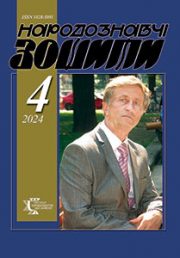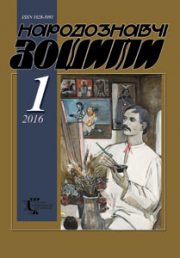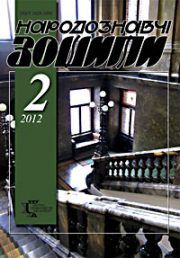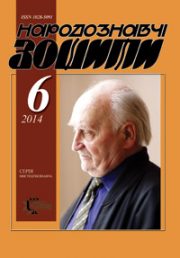The Ethnology Notebooks. 2023. № 5 (173), 1271—1283
UDK [398.7:82-94](=161.2):355.4(470-651.1:477)”2022″
DOI https://doi.org/10.15407/nz2023.05.1271
KUZMENKO Oksana
- ORCID ID: https://orcid.org/0000-0002-0512-6388
- Doctor of Science in Philology
- (Ph.D. in Folklore Studies), Senior Scholar,
- Leading Research Associate
- of Department of Social Anthropology
- The Ethnology Institute of the
- National Academy of Sciences of Ukraine,
- 15, Svobody Avenue, 79000, Lviv, Ukraine,
- Contacts:е-mail: kuzmenko.oksana@gmail.com
Abstract. The article is based on a paper presented at the 16th International Congress of the Society for Ethnology and Folklore (16th SIEF 2023).
Autobiographical narratives about the current war, including motifs of prophetic dreams, nightmares, or full-oniric texts, have been elements of everyday communication since the first days of the full-scale Russian invasion of Ukraine.
The article’s purpose is to trace the genesis of the formation of oral dream narratives about the Russian-Ukrainian war, as well as pragmatics, narrative syntax, and folklore semantics. The object of the study is the Ukrainian oral narrative tradition. The subject is the traditionality and ways of narrating onyric texts «before the war» that are included in the modern discursive process as a communicative event. The main task is to study the plots and classify the symbolic images of onyric narratives with the motif of a «prophetic» dream, the mechanism of integrating a «prophetic» dream into an individual life story.
The source material of the article is field material — onyric texts originating from oral personal narratives, audio recordings of which were made by the author between March 2022 and September 2023, as well as printed and archival texts recorded as part of oral history research projects.
The theoretical and methodological basis of the study is based on the semantic-structural, narrative analysis of the verbal text of the dream. The methods of participant observation, autoethnography, and conceptual analysis are auxiliary.
In conclusion, the author argues that the verbalization of dream interpretation texts has proven to be a necessary communicative practice for overcoming trauma in uncertain times. Dreams of reclaiming the «small homeland» and thoughts of Victory over the enemy as a mythical «breakthrough» prevail. Oral autobiographical narratives with episodes of significant dreams included, the prognostic effect of which is not always clear, are more an original expression of subconscious attitudes towards the war, and a way to structure the present and to some extent control the uncertain future.
Keywords: modern folklore culture, life story, tradition, text, narrative, oneiric narrative, motif of a «prophetic» dream, symbolism, Russian-Ukrainian war.
Received 11.10.2023
REFERENCES
- Dieries and Dreams of the War. Documenting Experiences of War. Retrieved from: https://www.lvivcenter.org/researches/diaries-and-dreams-of-the-war/ (Last accessed: 19.09.2023) [in Ukrainian].
- Frank, R. (2011). Newslore: Contemporary Folklore on the Internet. Mississippi:University Press of Mississippi.
- Kilroe, P. (2000). The Dream as Text, The Dream as Narrative. Dreaming, 10, 125—137.
- Antsybor, D.V. (2015). The paradigm of Onyric Folklore. Dissertation for the degree of Candidate of Philological Sciences in the specialty 10.01.07. Folklore Studies. Taras Shevchenko National University of Kyiv. Kyiv [in Ukrainian].
- Tedlock, B., & Bulkeley, K. (Ed.). (2001). The New Anthropology of Dreaming. Dreams. New York: Palgrave Macmillan. Retrieved from: https://doi.org/10.1007/978-1-137-08545-0_17 (Last accessed:: 10.05.2022).
- Kozellek, R. (2015). Terror and Dreams. In The past future. On the semantics of historical time (Pp. 281—301). Kyiv: Dukh i Litera [in Ukrainian].
- Palmenfelt, U. (2011). Narrating Cultural Heritage. Journal of Ethnology and Folkloristics, 4 (1), 63—73.
- Virtanen, L., & Siikala, A-L. (Ed.). (1989). Dream-telling Today. Studies in Oral Narrative. Studia Fennica, 33, 137—145.
- Niebrzegowska, S. (1996). Polish Folk Dream Book. Lublin: M. Curie-Sklodowska’s University Press [in Polish].
- Shevchuk, T., & Stavytska, J. (2017). Ukrainian Oneirocritical Tradition of the Early Twentieth Century (research and texts). Kyiv: Duliby [in Ukrainian].
- Antsybor, D.V. (2012). The paradigm of Onyric Folklore. Mythology and Folklore, 4, 55—58 [in Ukrainian].
- Serebriakova, O. (2022). Marriage Divination in the Calendar Rituals of Ukrainians. Lviv: Institute of Ethnology of the National Academy of Sciences of Ukraine [in Ukrainian].
- Koval-Fuchylo, I. (2014). Ukrainian Lamentations: Anthropology of Tradition, Poetics of Text. Kyiv: NAS of Ukraine; Institute of Art Studies, Folklore and Ethnology [in Ukrainian].
- Stavytska, Y.V. (2017). Prophetic Dream in the Narrative Structure of a Folk Tale. Slavic World, 16, 148—172 [in Ukrainian].
- Senko, I. (2022). Listen, son… Folklore treasures of the couple Maria and Mykhailo Senko from the Transcarpathian village of Kelechyn in the records of their son Ivan. Uzhhorod: TIMRANI [in Ukrainian].
- Scientific archival fonds of manuscripts and phonorecordings of the Rylsky Institute of Art Studies, Folklore and Ethnology of the NAS of Ukraine. F. 28—3. Od. seve. 275. Arc. 1—51 [in Ukrainian].
- Scientific archival fonds of manuscripts and phonorecordings of the Rylsky Institute of Art Studies, Folklore and Ethnology of the NAS of Ukraine. F. 28—3. Od. save 248. Arc. 1—24[in Ukrainian].
- Karatsuba, M.Y. (2017). The motif of sleep in folk ballads of the Southern Slavs. Slavic World, 16, 134—147 [in Ukrainian].
- Dmytrenko, M. (Ed.). (2000). Folk dream book. Kyiv: Narodoznannya [in Ukrainian].
- Jung, C.G., Kotiuk, K., & Feshovets, O. (Ed.). (2013). Archetypes and the Collective Unconscious. Lviv: Astrolabe [in Ukrainian].
- «Forced Labor 1939—1945»: Interview Archive. Maria A. Interview za 506, 25.05.2006. Retrieved from: https://archiv.zwangsarbeit-archiv.de/en/interviews/za506 (Last accessed: 19.09.2020) [in Ukrainian].
- Gulyas, J. (2007). A Function of Dream Narratives in Fairy Tales. FOLKLORE, 36, 129—140.
- Ivanauskaite-Seibutiene, V. (2016). Dreamed communion: household relations in traditional dream stories. Folktales works (Vol. 51, pp. 111—127) [in Lithuanian].
- Cywinski, P. (2016). Camp Dreams in the Memory of Auschwitz Survivors. Auschwitz: Auschwitz-Birkenau State Museum [in Polish].
- «Moscow Burned and Drowned» has gained 3 million views: how a band from Cherkasy became popular. Channel 5. Retrieved from: https://www.youtube.com/watch?v=lcqIO2snkFg (Last accessed: 10.09.2023) [in Ukrainian].
- Ellis, C., Adams, T.E., & Bochner, A.P. (2011). Autoethnography: an overview. Historical Social Research, 36 (4), 273—290.
- Ivanauskaite-Seibutiene, V. (2022). Dreams of Cars and Consolation: Reflection of on Funeral Rites in the Dream Narratives. Folklore Studies, 63, 11—34 [in Lithuanian].
- Kuzmenko, O. (2022). «Russians in the Ukrainian Folklore from the 20th and Early 21st Centuries: The Dynamics of the Images and Contexts». Tautosakos darbai (Vol. 64, pp. 15—56).
- The owl «Varya» works in Reconnaissance. Ukrainian Tik-Tok Army UA. Retrieved from: https://www.youtube.com/watch?v=4qYZjK5zohE (Last accessed: 02.06.2023) [in Ukrainian].
- Kaivola-Bregenhoj, А. (1993). Dreams as Folklore. Fabula, 3—4 (Vol. 34, pp. 211—224).







